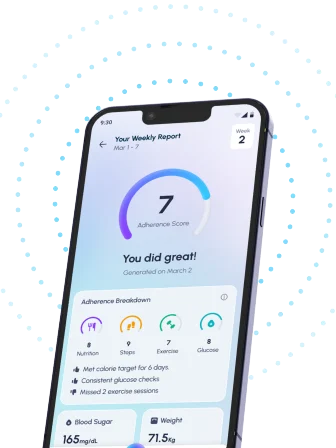Table of Contents
- Understanding Angina Pectoris: A Diabetic’s Guide
- Chest Pain in Diabetics: Recognizing Angina Symptoms
- Is It Angina or Heartburn? Diabetic Chest Pain Explained
- Managing Angina: Treatment Strategies for Diabetics
- Preventing Angina Attacks: Lifestyle Tips for Diabetics
- Frequently Asked Questions
- References
Experiencing chest pain as a diabetic can be incredibly frightening, leaving you wondering what’s happening and what to do next. The truth is, chest pain isn’t always a heart attack, but it’s crucial to understand the potential causes. This blog post focuses on Understanding Angina: A Diabetic’s Guide to Chest Pain, providing you with essential information to help you recognize the symptoms, know when to seek immediate medical attention, and ultimately, feel more confident in managing your health. We’ll explore the connection between diabetes and angina, and offer practical advice for navigating this common concern. Let’s delve in!
Understanding Angina Pectoris: A Diabetic’s Guide
Diabetes significantly increases the risk of heart disease, and angina pectoris, or chest pain, is a common symptom. This is especially pertinent in India and other tropical countries, where diabetes prevalence is high. According to the International Diabetes Federation’s Diabetes Atlas, a substantial portion of people with diabetes – 61% are aged between 20-64 years, and 39% are aged 65+ years – learn more This means a large and growing population faces the risk of experiencing angina. Understanding angina and its connection to diabetes is crucial for early detection and effective management.
Recognizing Angina in Diabetics
Angina in diabetics can manifest differently than in non-diabetics. The pain might be less intense or even absent (silent ischemia), making it harder to recognize. Common symptoms include chest tightness, pressure, or squeezing sensation, often radiating to the jaw, neck, or arms. However, in diabetics, symptoms can be vague, such as fatigue, shortness of breath, or indigestion. Therefore, regular check-ups with your doctor are critical.
Managing Angina and Diabetes
Effective management involves a multi-pronged approach. Strict blood sugar control is paramount, as high blood glucose levels damage blood vessels and increase the risk of angina. Maintaining a healthy lifestyle with regular exercise (as advised by your doctor), a balanced diet low in saturated fats, and quitting smoking are vital. Your doctor may also prescribe medications to manage both diabetes and angina, potentially including antiplatelet drugs to prevent blood clots and nitrates to improve blood flow. As you age, managing diabetes becomes even more crucial, so it’s beneficial to understand the challenges and solutions associated with managing diabetes as you age.
Seeking Help in India and Tropical Countries
In India and other tropical countries, access to healthcare can vary. It’s essential to consult with a qualified physician or cardiologist immediately if you experience chest pain or discomfort, especially if you have diabetes. Don’t hesitate to seek medical attention – early diagnosis and treatment are crucial for preventing serious complications. Regular health screenings and proactive management of diabetes are essential steps in protecting your heart health. If you’re planning any travel, remember to check out our guide on traveling with diabetes for essential tips to ensure a safe and healthy journey.
Chest Pain in Diabetics: Recognizing Angina Symptoms
Experiencing chest pain can be alarming, especially for individuals with diabetes. Diabetes significantly increases the risk of cardiovascular complications, including angina, a type of chest pain caused by reduced blood flow to the heart. This heightened risk is further compounded by the strong link between diabetes and sleep apnea, which increases the likelihood of heart problems. Research indicates that diabetes is linked to a 70% increased risk of sleep apnea and related sleep disorders. This makes early recognition of angina symptoms crucial for diabetics in India and other tropical countries. This connection is explored further in our article on The Connection Between Diabetes and Sleep Apnea.
Understanding Angina in the Indian Context
Angina symptoms can vary, but common indicators include tightness, pressure, squeezing, or pain in the chest, often radiating to the left arm, jaw, neck, or back. The pain may feel like indigestion or heartburn, sometimes accompanied by shortness of breath, sweating, nausea, or lightheadedness. However, it’s crucial to remember that angina symptoms can be subtle or atypical in diabetic individuals, making diagnosis more challenging. Factors like neuropathy (nerve damage), common in diabetes, can even mask or alter the typical presentation of chest pain. Therefore, prompt medical attention is vital.
Seeking Immediate Medical Help
In India and tropical regions, access to healthcare can vary. If you experience chest pain or discomfort, especially if you have diabetes, do not delay seeking medical attention. Consult your physician or visit the nearest healthcare facility immediately. Early diagnosis and treatment of angina can prevent serious complications, such as heart attack. Regular check-ups, including blood pressure and cholesterol monitoring, are essential for managing diabetes and reducing the risk of cardiovascular disease. Don’t hesitate; your health is paramount. While this article focuses on chest pain, it’s important to remember that diabetes can manifest in other ways, such as heel pain.
Is It Angina or Heartburn? Diabetic Chest Pain Explained
Chest pain is a common concern, especially for individuals with diabetes. The high prevalence of diabetic neuropathy, affecting 30-50% of patients, can complicate diagnosis, as nerve damage can cause pain that mimics other conditions. Differentiating between angina (chest pain due to reduced blood flow to the heart) and heartburn can be particularly challenging. This is especially true in hot and humid climates common in many Indian and tropical countries, where gastrointestinal issues are prevalent.
Understanding the Differences
Angina pain often presents as a squeezing, pressure, or tightness in the chest, sometimes radiating to the jaw, arms, or back. It’s typically triggered by exertion and relieved by rest or medication like nitroglycerin. Heartburn, on the other hand, is usually a burning sensation in the chest or upper abdomen, often accompanied by acid reflux. While both can cause discomfort, the triggers and the nature of the pain are key differentiators. The presence of other symptoms, such as shortness of breath (which can also be a symptom of Does Diabetes Cause Tachycardia?), is also crucial to note.
Diabetic Neuropathy and Chest Pain
Diabetic neuropathy can further blur the lines. The nerve damage associated with diabetes can lead to atypical chest pain, making it difficult to determine the root cause. This is why accurate diagnosis is essential. Ignoring chest pain, especially in the context of diabetes, is dangerous. It’s vital to consult a doctor immediately if you experience persistent or unusual chest discomfort. Feeling unusually tired, such as is feeling sleepy after eating a sign of diabetes, can also be a warning sign and should be discussed with your physician.
Seeking Medical Attention in India and Tropical Countries
In India and other tropical regions, access to healthcare varies. Early diagnosis and prompt treatment are crucial. If you are experiencing chest pain and have diabetes, don’t hesitate to seek immediate medical attention. Discuss your symptoms with your doctor, providing a detailed history of your pain, including location, intensity, triggers, and duration. Early intervention can significantly improve outcomes and prevent complications.
Managing Angina: Treatment Strategies for Diabetics
Angina, characterized by chest pain or discomfort, presents unique challenges for individuals with diabetes. Managing this condition effectively requires a multi-pronged approach that considers the interplay between diabetes and cardiovascular health. Maintaining optimal blood sugar levels is paramount, as high blood glucose can worsen existing cardiovascular issues and increase the risk of angina. For people with diabetes, blood pressure targets are generally below 140/90 mmHg, although some guidelines recommend aiming for below 130/80 mmHg. Achieving these targets through lifestyle modifications and medication is crucial in mitigating angina risk.
Lifestyle Changes for Angina Management
Lifestyle interventions play a vital role in managing angina in diabetic patients. A balanced diet low in saturated and trans fats, rich in fruits, vegetables, and whole grains, is essential. For specific dietary recommendations, you might find the ultimate diet chart for diabetic patients helpful. Regular physical activity, tailored to individual fitness levels, helps improve cardiovascular health and reduces angina episodes. Stress management techniques like yoga and meditation can also be beneficial, as stress can trigger angina attacks. Quitting smoking is another critical lifestyle change, significantly reducing the risk of cardiovascular complications. In tropical climates, staying hydrated is also crucial to manage blood pressure and reduce the risk of angina related to dehydration.
Medical Interventions for Angina in Diabetics
Medication forms a cornerstone of angina management in diabetic individuals. Your doctor may prescribe medications to lower blood pressure, control blood sugar, and reduce cholesterol levels. Beta-blockers, calcium channel blockers, and nitrates are commonly used to alleviate angina symptoms and improve heart function. Aspirin may be prescribed to prevent blood clots. Regular check-ups with your doctor and cardiologist are essential to monitor your condition, adjust medication as needed, and address any concerns promptly. Open communication with your healthcare provider is crucial for effective angina management and overall health. Don’t hesitate to discuss any concerns or symptoms you experience.
Seeking Expert Advice in India and Tropical Countries
Accessing quality healthcare is essential for managing angina, especially in India and other tropical countries. Seek advice from a qualified cardiologist and diabetologist familiar with the specific challenges faced in your region. Remember that proactive management is key to preventing serious complications. Regular check-ups, adherence to prescribed medications, and lifestyle changes can significantly improve your quality of life and reduce the impact of both diabetes and angina. Effective diabetes management is also key, and you can learn more about that with 10 proven tips for effective diabetes management.
Preventing Angina Attacks: Lifestyle Tips for Diabetics
Managing diabetes effectively is crucial in preventing angina, a type of chest pain caused by reduced blood flow to the heart. For individuals in India and other tropical countries, where lifestyle factors significantly impact diabetes prevalence, adopting a proactive approach is vital. Studies show that even seemingly minor habits like consuming sugary beverages significantly increase diabetes risk – by a startling 26%, according to research. This heightened risk directly translates to a greater chance of developing angina.
Dietary Changes for Angina Prevention
Prioritize a balanced diet low in saturated and trans fats, found abundantly in many processed foods common in Indian and tropical cuisines. Focus on fresh fruits, vegetables, and lean proteins. Control your carbohydrate intake, especially refined carbohydrates like white rice and sugary sweets, to manage blood sugar levels effectively. Remember, controlling blood sugar is a key step in preventing angina attacks.
Lifestyle Modifications
Regular physical activity is paramount. Aim for at least 30 minutes of moderate-intensity exercise most days of the week. This could include brisk walking, yoga, or other activities suitable to the tropical climate. Quitting smoking, if applicable, is essential as smoking severely constricts blood vessels, exacerbating angina risk. Managing stress through techniques like meditation or deep breathing exercises can also significantly reduce the frequency of angina attacks.
Seeking Professional Medical Advice
Regular check-ups with your doctor and cardiologist are crucial. They can help you create a personalized plan that considers your specific health conditions and risk factors, particularly relevant for those living in regions with high diabetes prevalence like India. Early diagnosis and consistent management are key to preventing serious complications. Don’t hesitate to seek medical attention if you experience chest pain or discomfort. For more information on managing diabetes to protect your heart, read our article on Protect Your Heart from Diabetes: 5 Essential Steps. Learning How to Prevent Long-Term Complications of Diabetes: Easy Tips is also crucial for overall health and well-being.
Frequently Asked Questions on Angina
Q1. What is the link between diabetes and angina?
Diabetes significantly raises your risk of angina, a type of chest pain caused by reduced blood flow to the heart. This is because diabetes damages blood vessels.
Q2. Can angina in diabetics feel different than in non-diabetics?
Yes, angina symptoms might be unusual or even absent in people with diabetes (silent ischemia). Instead of chest pain, you might experience fatigue, shortness of breath, or indigestion.
Q3. How can I reduce my risk of angina if I have diabetes?
Effective diabetes management is key. This includes maintaining healthy blood sugar levels, adopting a healthy lifestyle (diet, exercise, no smoking), and taking prescribed medications as directed by your doctor. Addressing sleep apnea, if present, is also important.
Q4. What should I do if I experience chest pain?
Seek immediate medical attention if you have chest pain, especially if you have diabetes. Don’t delay; prompt treatment is crucial to prevent serious heart problems.
Q5. What role does regular check-up play in preventing angina?
Regular check-ups with your doctor are vital for monitoring your blood sugar, blood pressure, and overall cardiovascular health. Early detection and management of diabetes are key to preventing angina and its complications.
References
- A Practical Guide to Integrated Type 2 Diabetes Care: https://www.hse.ie/eng/services/list/2/primarycare/east-coast-diabetes-service/management-of-type-2-diabetes/diabetes-and-pregnancy/icgp-guide-to-integrated-type-2.pdf
- Your Guide to Diabetes: Type 1 and Type 2: https://www.niddk.nih.gov/-/media/Files/Diabetes/YourGuide2Diabetes_508.pdf




